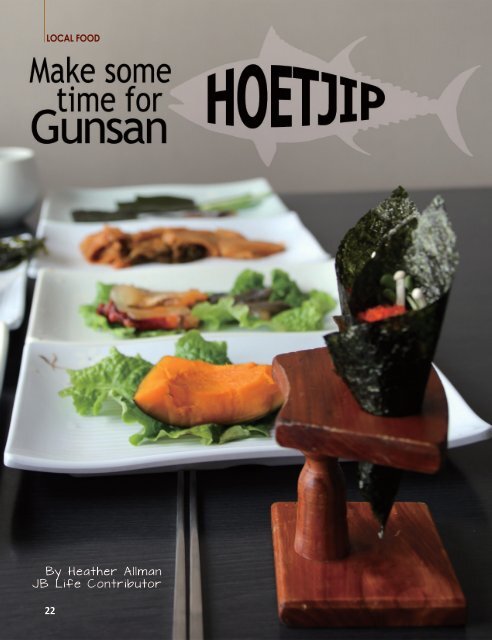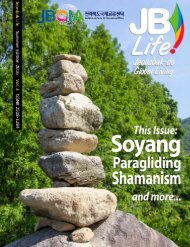JB Life March 2017
The Spring version of JB Life, North Jeolla's quarterly global lifestyle magazine.
The Spring version of JB Life, North Jeolla's quarterly global lifestyle magazine.
You also want an ePaper? Increase the reach of your titles
YUMPU automatically turns print PDFs into web optimized ePapers that Google loves.
LOCAL FOOD<br />
By Heather Allman<br />
<strong>JB</strong> <strong>Life</strong> Contributor<br />
Hoetjip, 회집, pronounced roughly as<br />
“hway-chip,” is a restaurant whose main<br />
dish presents itself abundantly in most<br />
Korean towns or cities on the water, while restaurants<br />
can also be found scattered throughout landlocked<br />
areas as well. “Hoe” (hway) itself is any sort<br />
of raw dish, but is primarily used in regards to raw<br />
fish. Situated on the west coast of Korea on the south<br />
bank of the Geum River, just upstream from its exit<br />
to the Yellow Sea, Gunsan is known for its seaport,<br />
which brings along with it a strong industrial trade<br />
industry as well as an abundance of delicious seafood.<br />
Gunsan is known as one of the best places in<br />
Korea to find a hoetjip, with restaurants from Seoul<br />
to Busan named “Gunsan Hoetjip” after the city and<br />
its local delicacy.<br />
Prior to traveling to Gunsan, my knowledge of the<br />
hoetjip was, let’s say, undercooked. While I did my<br />
research pinpointing areas and suggested restaurants<br />
to try, I was unsure of exactly what I would be eating.<br />
I have found that an important part of living in Korea<br />
and trying new foods is the adventure that comes<br />
along with it. Each time I try something new, I’m not<br />
only eating a meal, I’m deepening my understanding<br />
of Korea’s rich and flavorful culture.<br />
In my limited amount of research, I learned that<br />
most of the restaurants in Gunsan were simply named<br />
something like “Hoetjip” and were all situated next<br />
to one another along the seawall on the port. I chose<br />
Kunsan Seafood Restaurant for a couple of reasons.<br />
It had a significant (enough) online presence (albeit<br />
a bit limited in English) and it seemed to be one of<br />
the largest restaurants in the area. While I do love the<br />
authenticity of a mom-and-pop type place, because<br />
I was traveling to Gunsan with the sole purpose of<br />
trying a certain type of food, I wanted to have a good<br />
idea of where I was going. A fresh seafood lunch in<br />
an eight story restaurant on the water sounded worth<br />
the time and effort to me.<br />
As the taxi neared the seawall, snow lightly fell<br />
from the grey afternoon sky. I questioned whether<br />
or not this was a setting in which I wanted to sit near<br />
the water and eat raw fish. It tends to be something<br />
I might imagine myself enjoying on a hot summer’s<br />
day or on vacation on a tropical island. As the taxi<br />
rode along the long wall, hoetjip restaurants lined the<br />
narrow street on our left, only the open river full of<br />
boats and ships on our right. We soon arrived at Kunsan<br />
Seafood Restaurant, directly situated across from<br />
a large arched bridge.<br />
Walking inside the building, it was more reminiscent<br />
of a fish market than anything else. After being<br />
escorted to an elevator and instructed to take it to the<br />
fourth floor, the doors opened to a warm, eloquent atmosphere.<br />
Deep wood tones stretched from the floor<br />
to the ceiling, with low and natural lights providing a<br />
sense of calm and serenity. We were led to a private<br />
room, our table adjacent to a large window<br />
g<br />
22 Jeonbuk <strong>Life</strong> 23







